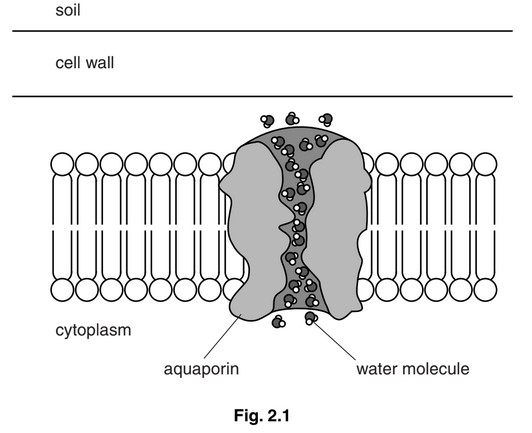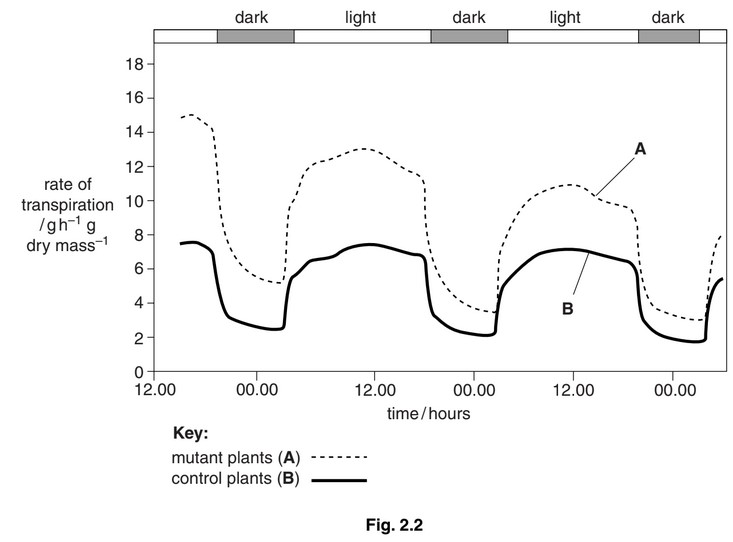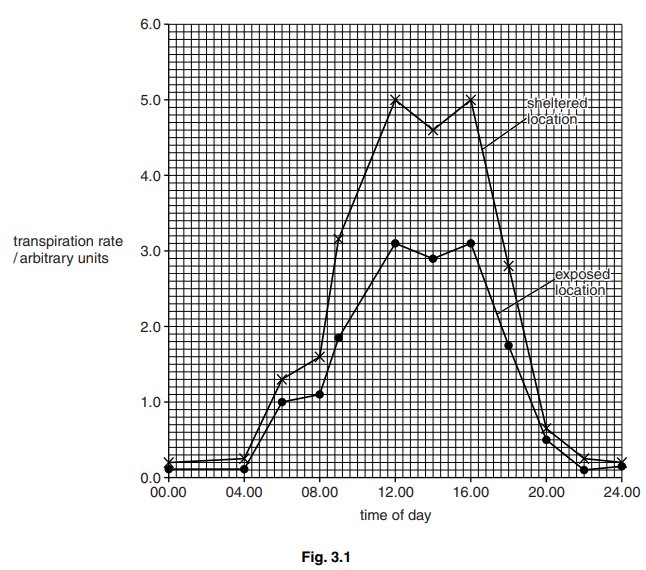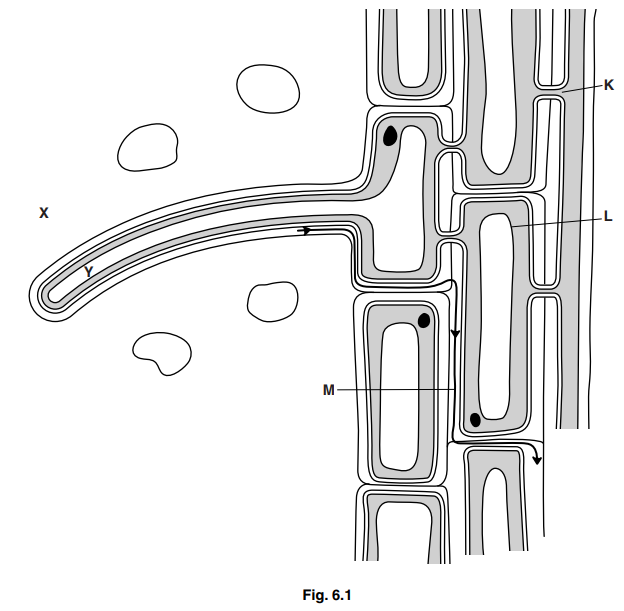Question
Thale cress, Arabidopsis thaliana, is used to study the roles of genes and proteins in plants.
The cell membranes of the root hairs of A. thaliana contain proteins called aquaporins that
allow the movement of water between the soil and the cytoplasm as shown in Fig. 2.1.

(a) With reference to Fig. 2.1:
(i) explain how water is absorbed by root hairs of A. thaliana
(ii) state why aquaporins are necessary in cell surface membranes.
(b) Describe the pathway taken by water from the cytoplasm of the root hair cell to a xylem
vessel in the centre of the root.
An investigation was carried out to find the effect of an enzyme in A. thaliana on the
composition of the cuticle. The enzyme is involved in the production of lipid that accumulates
in the cuticle.
Plants were discovered with a mutation of the gene that codes for the enzyme.
Some of these mutant plants (Group A) were grown in pots and their rate of transpiration
was determined over three days. They were compared with control plants (Group B) in which
the gene was switched on and the enzyme present. The results are shown in Fig. 2.2.

(c) With reference to Fig. 2.2, explain:
(i) why the rate of transpiration is higher during the day than at night in both groups of plants
(ii) how the results show that the cuticle is less effective in the mutant plants.
Answer/Explanation
Answer:
(a) (i) 1 diffusion through (freely permeable) cell wall;
2 membrane is partially permeable ; A selectively
3 osmosis across membrane (into cell)
4 (only) some water may pass between phospholipids (across membrane);
5 movement across membrane facilitated by aquaporins ;
6 ref. down water potential gradient / from high water potential to low water potential;
A from a higher / to a lower, water potential if in context
7 AVP ; e.g. further detail about aquaporin (hydrophilic channel)
(ii) 1 increases permeability of membrane to water ;
2 idea that osmosis across bilayer does not supply cell rapidly enough with water (that needs to pass on to surrounding cells) ;
3 idea that phospholipids are relatively impermeable to water ;
4 idea that water cannot pass / only some water passes, through hydrophobic
region of membrane / AW ;
(b) pathway via, cells of cortex / cortical cells, and endodermis / endodermal cells ;
symplast pathway, described as
cytoplasm and, plasmodesmata / vacuole(s) ;
(out of cell to) apoplast pathway, described as
cell wall pathway ;
Casparian strip / suberised cell wall, of endodermis, impermeable to water ;
(so) pathway only via, symplast / cytoplasm ;
AVP ; e.g. reference to pericycle
reference to passage cells of endodermis
vacuolar pathway (unless given in mp 2)
(c) (i) stomata are open (to absorb carbon dioxide for photosynthesis) ; ora
(ii) rate of transpiration, (almost) always / AW, higher / higher at night, in A / mutant
plants ; ora
A expressed in terms of water loss
at night only cuticular transpiration / no stomatal transpiration ;
idea that during day stomatal transpiration same for both ;
(so) differences because of less effective cuticle ;
comparative data quote ;
Question
(a) Transpiration is often described as an ‘inevitable consequence of gas exchange in plants’.
Explain what is meant by this statement.[3]
The buttonwood tree, Conocarpus erectus, grows in coastal areas of the Americas. A study was carried out on its ability to survive on Socorro Island off the Pacific coast of Mexico. The island is exposed to high winds, which can lead to high rates of transpiration.
The transpiration rates of trees at sheltered and exposed locations at the same altitude on Socorro Island were compared. The results are shown in Fig. 3.1.

(b) Describe the results shown in Fig. 3.1.[5]
(c) The leaves of the buttonwood trees at the exposed site were significantly smaller than those at the sheltered site.
Describe three ways, other than small size, in which leaves are adapted to reduce the rate of transpiration.[3]
1
2
3
[Total: 11]
Answer/Explanation
Ans:
3 (a) R CO2 diffusion is a consequence of transpiration
stomata open(ings) to allow carbon dioxide in ;
carbon dioxide required for photosynthesis ;
ignore ref. to oxygen
water vapour diffuses out through stomata ;
A water if evaporation (from mesophyll walls) described
A water as a gas
(b) 1 both show, little/ low/ lowest, transpiration, at night/ 22.00 to 24.00/ 00.00 to 04.00 ;
2 both, increase to / peak, at mid day / 12.00 ;
3 ref. to second peak at 16.00 ;
4 both, dip / decrease, at 14.00 ;
5 transpiration (always) lower for trees at exposed site/ ora ;
6 both decrease from 16.00 ;
for mps 1–4 and mp 6, allow a description at one site only
R if contradictory description given for the other site
7 comparative data quote to support above marking points ; ;
8 to compare the transpiration rate at two locations at the same time or transpiration rate at one location at different times
to award data marks arbitrary units (au) must be used at least once
(c) identification of the following features
1 stomata close (for longer), during the day /when hot/when dry ;
2 stomata in pits / sunken stomata ;
3 stomata only on lower surface of the leaf ;
4 hairs / trichomes ;
5 low number of/ few(er)/ less, stomata (per unit area) ;
ignore ‘less open stomata’
6 thick(er) cuticle;
7 reflective cuticle (on upper epidermis) ;
8 thick(er) epidermis / more than one layer of epidermal cells ;
9 curled/rolled/AW, leaves ;
Question
Fig. 6.1 shows the pathway taken by water as it enters the root of a flowering plant.

(a) Explain how water passes from X to Y.[3]
(b) Name:
(i) the structures K and L.[2]
K
L
(ii) the pathway indicated by M.[1] [Total: 6]
Answer/Explanation
Ans:
6 (a) ref.to cell wall freely permeable ;
(through) cell surface membrane/vacuolar membrane or tonoplast ;
A partially permeable, membranes
(by) osmosis ;
movement from high water potential to low water potential ; A down water potential gradient ref. aquaporins ;
(b) (i) K – plasmodesma ;
L – vacuolar membrane/tonoplast ; A vacuole
(ii) apoplast ;
